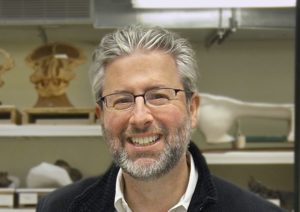
Neil Shubin has traversed the globe in his quest to fill in the fossil record, conducting field research in sites from Morocco to the Canadian Arctic. In a few weeks, he will add Antarctica to the list. Shubin, a paleontologist and evolutionary biologist, is popularly known for his discovery of Tiktaalik rosae — a transitional species between fish and land animals. This discovery forms the basis for his book “Your Inner Fish,” which was selected by the National Academy of Sciences as the best book of 2009 and has been adapted into an Emmy award-winning three-part special on PBS. He currently serves as the Robert R. Bensley Professor of Organismal Biology and Anatomy at the University of Chicago. The Daily sat down with Shubin to explore the challenges of discovery and the rewards of learning about the world through an evolutionary lens.
The Stanford Daily (TSD): When did you become interested in evolution?
Neil Shubin (NS): I was an undergrad at Columbia, and I volunteered at the American Museum of Natural History in New York, which is a playground for evolution. There were dinosaur exhibits and fish exhibits — I really got into it. I met one of the curators there who gave me a little research project to work on. It didn’t go anywhere, but the one thing it did was kindle an interest in research and paleontology. By the time I got to Harvard, I knew I wanted to be a paleontologist and study evolution, but I didn’t know what I was going to work on. At Harvard, I realized that I needed more than paleontology. I needed molecular biology, I needed biomechanics.
TSD: You said that one of the questions that drives you is finding great evolutionary transitions. Now that you’ve discovered Tiktaalik, do you feel like your approach has changed at all?
NS: I would like to think that I have a better sense of how to find [these fossils] and what it takes to do it. That’s what is going to guide us through Antarctica. We don’t know whether we’re going to be successful or not. We’re right where we were with Tiktaalik in 1999. It’s a whole new expedition.
The biggest part of fossil finding is confidence. Whenever I go to a new place, it takes me a while to see the fossils. I know my eye will be trained. I have confidence that I’ll get it eventually, because I’ve done it enough. It gives me patience.
TSD: What motivates you to make science accessible to the public?
NS: We live in a very technological and technical age where, when you think about agriculture, biomedicine, climate, oceans, the health and safety of our bodies and our planet — all that has at its core science. Yet at that same time, where science is really a critical part of the conversation, we have a huge segment of our population that either is intimidated by science, hates science, is suspicious of science or doesn’t have the tools to really consider science. That disconnect is what motivates me to some extent. But even more than that, my career in science was kindled by great teachers and great communicators. I grew up with the Apollo moon program. I grew up with Carl Sagan on TV. Is it any wonder I’m a scientist? If I can in some way, through the work I do, inspire, I will consider it a very good thing.
TSD: You’ve written “Your Inner Fish,” which explores billions of years of evolutionary history, and you’ve also written “The Universe Within,” which delves back farther into the history of the cosmos. What are the benefits you can get from looking at evolution through these different time scales?
NS: It shows how unusual our current modern age is. The things we take for granted — ice at the poles, for instance, which will be very important to me in a couple weeks — weren’t always there. The normal state of the earth is to not have ice at the poles. It teaches you about change, how dynamic everything is, from the organic world to the physical world. Mountains rise and fall, [as do] oceans, bodies and species. Importantly, and this is the theme of both books, science has taken our planet and humanity away from the center of the universe. We’re now this one little fleck in one margin of an insignificant little galaxy in the universe. But it’s also connected us deeply to it all, not just us as humans, but also us as animals, as living things, as things made of stardust. At those two different time scales, what I was able to appreciate was the beauty of the connections, and the dynamism that surrounds us. It makes you see the present world in a very different way.
TSD: You’re leaving on an expedition to Antarctica in a few weeks. What are some challenges that you anticipate facing?
NS: It will be zero to 10 degrees. It’ll be at moderate altitude, three to seven thousand feet, which is significant. It’ll be very dry. Logistically, it’s very difficult because we’re far away — we’re at the margin of where a helicopter can get to in Antarctica. We’re going to be six people, very self sufficient. Weather can change. Winds are huge. You can have 60 to 80 mile an hour winds, just off the bat. We’re good people, but it’s going to be physically hard. But the part that excites me most is just the adventure of it. We will figure it out, it’s going to take us time, and this is the part of the expedition I love — I just see the problem and the puzzle and I want to solve it. That’s the exciting bit for me: where are the fossils in this thing?
This transcript has been condensed and lightly edited.
Contact Claudia Heymach at cheymach ‘at’ stanford.edu.
